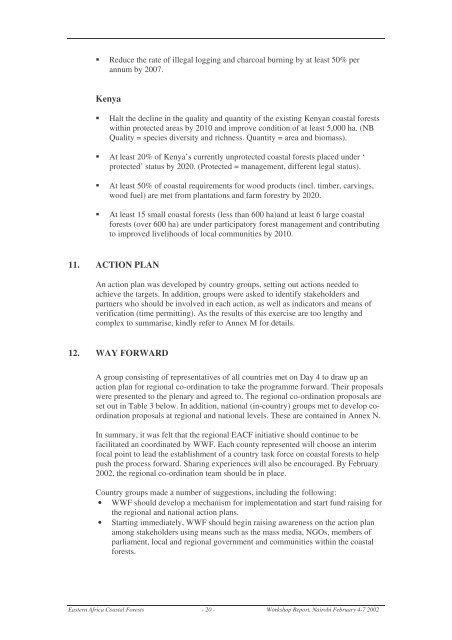Eastern Africa Coastal Forest Programme: Regional Workshop ...
Eastern Africa Coastal Forest Programme: Regional Workshop ...
Eastern Africa Coastal Forest Programme: Regional Workshop ...
You also want an ePaper? Increase the reach of your titles
YUMPU automatically turns print PDFs into web optimized ePapers that Google loves.
Reduce the rate of illegal logging and charcoal burning by at least 50% per<br />
annum by 2007.<br />
Kenya<br />
<br />
Halt the decline in the quality and quantity of the existing Kenyan coastal forests<br />
within protected areas by 2010 and improve condition of at least 5,000 ha. (NB<br />
Quality = species diversity and richness. Quantity = area and biomass).<br />
At least 20% of Kenya’s currently unprotected coastal forests placed under ‘<br />
protected’ status by 2020. (Protected = management, different legal status).<br />
<br />
<br />
At least 50% of coastal requirements for wood products (incl. timber, carvings,<br />
wood fuel) are met from plantations and farm forestry by 2020.<br />
At least 15 small coastal forests (less than 600 ha)and at least 6 large coastal<br />
forests (over 600 ha) are under participatory forest management and contributing<br />
to improved livelihoods of local communities by 2010.<br />
11. ACTION PLAN<br />
An action plan was developed by country groups, setting out actions needed to<br />
achieve the targets. In addition, groups were asked to identify stakeholders and<br />
partners who should be involved in each action, as well as indicators and means of<br />
verification (time permitting). As the results of this exercise are too lengthy and<br />
complex to summarise, kindly refer to Annex M for details.<br />
12. WAY FORWARD<br />
A group consisting of representatives of all countries met on Day 4 to draw up an<br />
action plan for regional co-ordination to take the programme forward. Their proposals<br />
were presented to the plenary and agreed to. The regional co-ordination proposals are<br />
set out in Table 3 below. In addition, national (in-country) groups met to develop coordination<br />
proposals at regional and national levels. These are contained in Annex N.<br />
In summary, it was felt that the regional EACF initiative should continue to be<br />
facilitated an coordinated by WWF. Each county represented will choose an interim<br />
focal point to lead the establishment of a country task force on coastal forests to help<br />
push the process forward. Sharing experiences will also be encouraged. By February<br />
2002, the regional co-ordination team should be in place.<br />
Country groups made a number of suggestions, including the following:<br />
• WWF should develop a mechanism for implementation and start fund raising for<br />
the regional and national action plans.<br />
• Starting immediately, WWF should begin raising awareness on the action plan<br />
among stakeholders using means such as the mass media, NGOs, members of<br />
parliament, local and regional government and communities within the coastal<br />
forests.<br />
<strong>Eastern</strong> <strong>Africa</strong> <strong>Coastal</strong> <strong>Forest</strong>s - 20 - <strong>Workshop</strong> Report, Nairobi February 4-7 2002
















